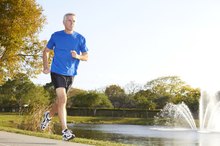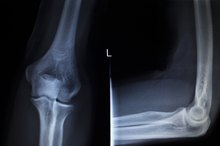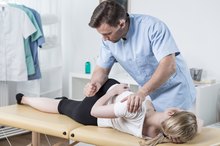What Are the Benefits of Passive Range of Motion?
Range of motion exercises are defined as those that offer three types of movement, according to Merck Manual Online Medical Library. Active exercise is that which an individual does for himself, while active assisted range of motion is achieved with the help of a therapist or individual who aids the person in the movement. Passive range of motion is exercise performed on an individual by another person, therapist or nurse. Passive range of motion exercises offer a variety of benefits for those unable to exercise for themselves.
Muscle Strength
Passive range of motion exercise helps prevent weak muscles or stiffness caused by non-use. When muscles aren't used and exercised on a regular basis, they become weak and unable to support joint function and range of motion. As the person or body part being exercised grows stronger, different forms of resistance may be used to help provide additional strengthening benefits, such as through resistance bands, pressure from the therapist or weights, according to the Merck Manual Online Medical Library.
Improve Circulation
Exercise Programs for Peripheral Neuropathy
Learn More
Anyone who is required to spend a lot of time in a wheelchair or on bed rest may benefit from passive range of motion exercises that help increase and improve circulation by keeping joints and muscles functioning and healthy, according to Family Friendly Fun, a website devoted to family fun and health and dealing with special needs and disability support. Passive range of motion exercise helps prevent blood from pooling in the extremities or the lower torso, which may lead to skin breakdown known as decubitus ulcers or bedsores. Passive range of motion exercises also help promote increased cardiac capacity, which helps pump oxygen-rich blood to all cells and tissues in the body.
Maintain Flexibility
Without regular movement , the joints in the body become stiff and unbending. In some who are unable to move, such as those who have been paralyzed, muscle atrophy and contractions may occur, which literally waste away muscle tissue and cause the limbs to curl inward toward the center of the body. This can be extremely painful. Passive range of motion helps prevent joints from stiffening and helps increase joint health by keeping joints lubricated and flexible, according to Drugs.com.
- Without regular movement , the joints in the body become stiff and unbending.
Reduce Pain
How Can Exercise Improve Your Muscular System?
Learn More
Exercising the joint helps keep them limber, which reduces pain caused by stiffness. Individuals who cannot move on their own or do not have the strength to do so may benefit from passive range of motion exercise that prevents contractures, according to the ALS-MDA News Magazine, sponsored by the MDA ALS Division. (The abbreviations stand for amyotrophic lateral sclerosis and muscular dystrophy, respectively.) Contractures are caused by atrophy and shortening of muscles or joints that are not used, resulting in painful deformities.
- Exercising the joint helps keep them limber, which reduces pain caused by stiffness.
Related Articles
References
- Merck Manual Online Medical Library: Physical Therapy
- FamilyFriendlyFun.com: Passive Range of Motion
- Drugs.com: Passive Range of Motion Exercises Care Guide Information
- Bandy WD, Sanders, B. Therapeutic Exercise for Physical Therapist Assistants. Philadelphia, PA: Lippincott, Williams & Wilkins; 2008.
- Kisner, C., & Colby, L. A. (1996). Therapeutic exercise: Foundations and techniques. (3 ed.). Philadelphia: FA Davis.
- Soucie JM, Wang C, Forsyth A, et al. Range of motion measurements: reference values and a database for comparison studies. Haemophilia. 2011;17(3):500-7. doi:10.1111/j.1365-2516.2010.02399.x
- Magee DJ. Orthopedic Physical Assessment - E-Book. Elsevier Health Sciences; 2014.
- Marek SM, Cramer JT, Fincher AL, et al. Acute Effects of Static and Proprioceptive Neuromuscular Facilitation Stretching on Muscle Strength and Power Output. J Athl Train. 2005;40(2):94-103.
- Physical Therapy (PT). Merck Manual Professional.
- Normal Joint Range of Motion Study. Centers for Disease Control.
- Behm DG, Blazevich AJ, Kay AD, McHugh M. Acute Effects of Muscle Stretching on Physical Performance, Range of Motion, and Injury Incidence in Healthy Active Individuals: A Systematic Review. Appl Physiol Nutr Metab. 2016 Jan;41(1):1-11. doi: 10.1139/apnm-2015-0235. Epub 2015 Dec 8.
- Hwang J, Jung MC. Age and Sex Differences in Ranges of Motion and Motion Patterns. Int J Occup Saf Ergon. 2015;21(2):173-86. doi: 10.1080/10803548.2015.1029301.
- Nakano J, Yamabayashi C, Scott A, Reid WD. The Effect of Heat Applied With Stretch to Increase Range of Motion: a Systematic Review. Phys Ther Sport. 2012 Aug;13(3):180-8. doi: 10.1016/j.ptsp.2011.11.003. Epub 2011 Dec 29.
Writer Bio
Denise Stern is an experienced freelance writer and editor. She has written professionally for more than seven years. Stern regularly provides content for health-related and elder-care websites and has an associate and specialized business degree in health information management and technology.








